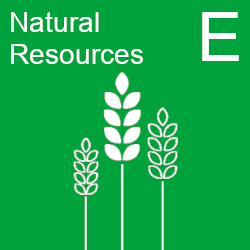Notice: From 01 December 2025, the Outcome Indicator Framework dashboard has been moved. Future updates to this publication are available on GOV.UK at: Environmental Indicator Framework.
Short Description
To produce food and feed, farming uses a range of inputs including fertilisers, pesticides, energy and animal feed. In addition, labour and land is required as well as depreciation of capital. Minimising the use of these inputs is an important policy driver to improve productivity and hence improve profitability whilst reducing the environmental impacts of farming. Farm practices and the use of inputs (particularly fertilisers and pesticides) directly influence the environmental pressures from farming including the quality, composition and availability of habitats and impact on air, water and soils. Volume of inputs may therefore be considered an indirect measure of pressure on a range of natural capital assets.
This indicator should be viewed alongside indicator ‘E2 Volume of agricultural production’ and other indicators in the framework relating to the condition of natural capital assets. The index of the volume of inputs is an overall measure of the total inputs used with price effects removed. This includes all inputs including intermediate consumption, land, labour and depreciation of capital.
Readiness and links to data
The data presented in this indicator are derived from the official statistics on total factor productivity for England by farm type. These total factor productivity data are collated via the Farm Business Survey and are updated annually.
Indicator components
Figure E3: Volume of inputs used in agricultural production in England, 1990/1991 to 2023/2024
Table E3: Volume of inputs used in agricultural production in England, 1990/1991 to 2023/2024
| Year | Value |
|---|---|
| 1990/1991 | 100.00 |
| 1991/1992 | 100.48 |
| 1992/1993 | 94.46 |
| 1993/1994 | 94.70 |
| 1994/1995 | 95.26 |
| 1995/1996 | 98.55 |
| 1996/1997 | 98.02 |
| 1997/1998 | 96.50 |
| 1998/1999 | 95.11 |
| 1999/2000 | 92.57 |
| 2000/2001 | 85.02 |
| 2001/2002 | 93.72 |
| 2002/2003 | 91.30 |
| 2003/2004 | 90.67 |
| 2004/2005 | 87.87 |
| 2005/2006 | 85.12 |
| 2006/2007 | 84.42 |
| 2007/2008 | 85.53 |
| 2008/2009 | 84.97 |
| 2009/2010 | 87.29 |
| 2010/2011 | 88.04 |
| 2011/2012 | 85.35 |
| 2012/2013 | 88.08 |
| 2013/2014 | 88.86 |
| 2014/2015 | 91.40 |
| 2015/2016 | 89.87 |
| 2016/2017 | 90.47 |
| 2017/2018 | 87.60 |
| 2018/2019 | 91.28 |
| 2019/2020 | 90.71 |
| 2020/2021 | 87.88 |
| 2021/2022 | 83.55 |
| 2022/2023 | 81.53 |
| 2023/2024 | 85.32 |
Trend description for E3
The volume of inputs used in agricultural production in England has shown an overall decrease of 14.7% since 1990/1991. Most of this decrease took place between the mid-1990s and 2006/2007. Following a period of steady increase to 2014/2015, volumes remained relatively stable until 2019/2020 when they began to fall again. Most recently (between 2022/2023 and 2023/2024), the volume of inputs used in agricultural production in England has increased by 4.6%.
Assessment of change
There has been a decrease in the volume of inputs used in agricultural production over the short-, medium- and long-term assessment periods. However, it is not possible to simplistically categorise these changes as either an ‘improvement’ or ‘deterioration’ for the environment as this will depend on the types of input driving change. An increase in inputs of pesticide and fertiliser would likely have a negative effect, but this indicator also includes other inputs such as labour. This indicator is included in the Outcome Indicator Framework to help interpret the reasons behind changes in ‘E4 Efficiency of agricultural production measured by Total Factor Productivity’.
Change since 2018 has also been assessed. There has been a decrease in volume of inputs used in agricultural production since 2018.
Further information on this assessment, along with details on the methodology, is provided in the Assessment background page. Summaries by 25 Year Environment Plan goal and information on indicator links are presented in the Assessment results pages.
Table E3: Assessment of change
| Component | Period | Date range | Percentage change | Smoothing function | Assessment of change |
|---|---|---|---|---|---|
| E3 | Short term | 2018/2019 to 2023/2024 | -4.59 | Loess | Change (decreasing) |
| E3 | Medium term | 2013/2014 to 2023/2024 | -4.79 | Loess | Change (decreasing) |
| E3 | Long term | 1990/1991 to 2023/2024 | -15.34 | Loess | Change (decreasing) |
Note that assessment categories were assigned based on smoothed data, so percentage change figures in Table E3 may differ from unsmoothed values quoted elsewhere. It is not possible to define a simplistic desired direction of change for this indicator so we cannot assign an ‘improvement’ or ‘deterioration’ label to these results.

